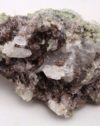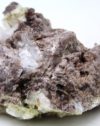HISTORY, NAME, LOCALITIES: Uvite, pronounced YOU-vite, was recognized as a mineral species in 1929 and named for its discovery location in Uva Province in Sri Lanka (formerly Ceylon). Uvite is collected in Brazil, Pakistan, Madagascar, Namibia, Sri Lanka, Myanmar, Canada, Mexico, and the United States (New York, Arkansas, Colorado, New Hampshire).
MINERALOGY, PROPERTIES, OCCURRENCE: Uvite [basic calcium magnesium aluminum oxyborosilicate, CaMg3Al6(BO3)3(Si6O18)(OH)3O] is an uncommon, calcium-magnesium-rich member of the tourmaline group and crystallizes in the hexagonal system (trigonal subsystem) as stubby, striated prisms with hexagonal cross sections. It is transparent to nearly opaque, has a vitreous luster, lengthwise striations, and is usually black, greenish-black, brownish-black, or dark green. It has a substantial Mohs hardness of 7.0-7.5, no cleavage, and a specific gravity of 2.9-3.2. Uvite occurs primarily in calcium- and boron-rich, metamorphic and skarn-type environments. In 2011, mineralogists employed advanced quantitative-analytical methods to redefine uvite as two separate minerals that are end-members of a solid-solution series: Uvite now refers to the hydroxyl-dominant end-member, while fluor-uvite is the correct name for the fluorine-dominant end-member.
METAPHYSICAL PROPERTIES, LORE, USES: Modern metaphysical practitioners believe that uvite diminishes fears and promotes self-confidence, awakens one from illusions, brings an awareness of reality, and enhances fortitude. Uvite has neither technological nor jewelry uses.
COLLECTORS’ INFORMATION: Uvite is collected because of its rarity and frequent association in attractive composite specimens with such minerals as quartz, muscovite, and apatite-(CaF).





 Axinite #10
Axinite #10  Axinite #8
Axinite #8